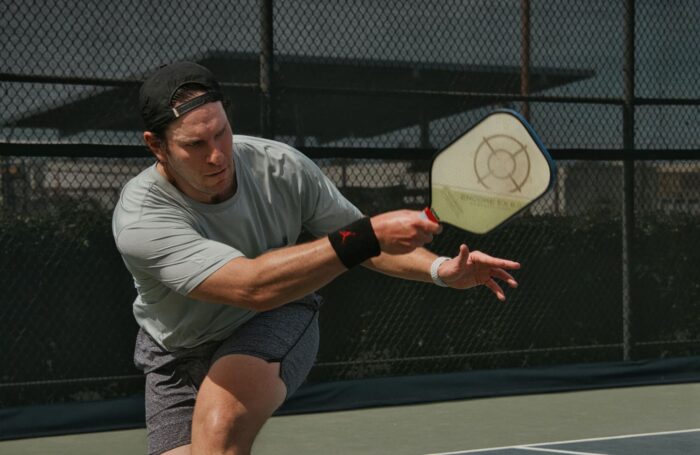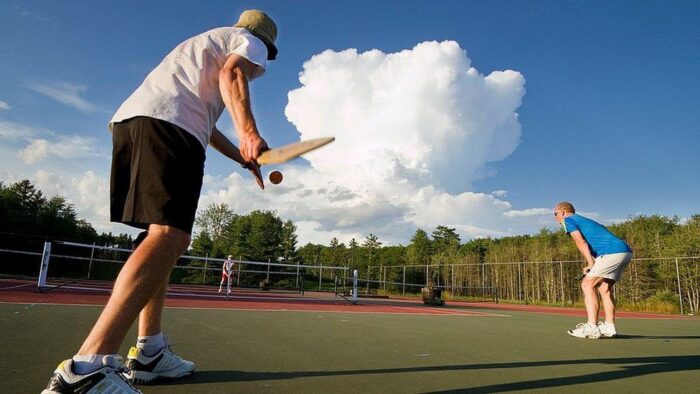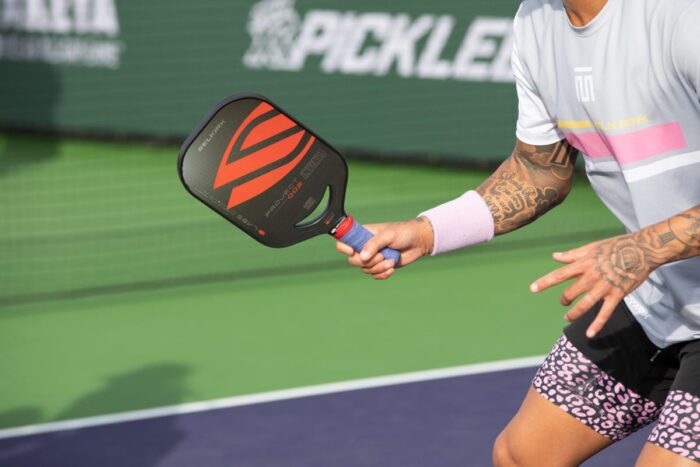If you perfect your spin in pickleball, you can hit the ball harder as well. It’s the same as when you hit a ball with the back of your racket in tennis. Doing so gives the ball increased power. Also, when you rotate your wrist perfectly, you create a centrifugal force on the paddle. This is known as snapping the wrist.
Therefore, when you snap the wrist, you also place a top spin on the ball, both which allow you to direct the ball to where you want it to go. You can produce this effect with your pickleball paddle. While you’ll need the paddle to perfect the spin, you also have to exert some patience to achieve what you’re hoping to accomplish with your spin.
Pickleball Paddles and Spins: Factors to Consider
Regardless of the types of pickleball paddles used, you can use the equipment to make contact with the ball at a specific speed. The spin you create is determined by several factors, namely the following:
- A paddle’s width
- How you’re standing
- The angle at which you strike the ball
- When your paddle and the pickle ball make contact
When you are practicing your spin then, you need to make sure you achieve synchrony, or that your paddle rotates in harmony with the ball. A bad strike is generally off-pace, which requires your opponent to hit the ball harder than normal.
This information is common knowledge to most tennis players, who tend to place a spin on the ball quite frequently. If you move your pickleball paddle from a low to high position, you’ll automatically create a topspin on the ball, something that is helpful if you hit a lob, which you want to place deep, or just inside the baseline. The spin can also work while serving if you want your ball to bounce hard toward your rival.
Getting the Grip Right: Neutralizing How You Hold the Paddle
The most common grip in pickleball is the continental grip. You can also find out what size of paddle grip you should use when you visit the site that covers this detail. A neutral grip, the continental grip, is important to learn.
To create this grip, you need to even out your hold on the forehand and backhand sides of the paddle. Think of this grip as the same one you use when you’re shaking hands. While it’s not a strong forehand grip, it’s also not weak. Again, it’s considered neutral. The same can be said for the backhand grip as well.
Therefore, using this grip not only steps up reaction times, it creates quicker exchanges at the kitchen line. Also, by using a continental grip, your paddle face remains open, which generates more of a spin on the ball.
Any spin you create should look natural. Don’t use a choppy movement, which is far from natural-looking or downplayed. Instead, the exaggerated motion often directs the ball to the bottom of the net or causes the ball to go high so the opponent can put it away.
Go with the Flow

Source: padeljoy.com
Maybe you’re an ex-racquetball player who has taken up pickleball. Because of your past playing experience, you may use too much wrist action, which imparts a type of sidespin that leads to crazy bounces, all of which can lead to a lot of missed serves. Therefore, you need to go with the flow when you create a spin in pickleball.
Remember: The Pickleball Ball is Light
Remember, unlike a racquetball ball, the pickleball ball is light, so the physics aren’t exactly the same. Therefore, when you hit a shot, you want to make sure something, which is in your control, happens.
By working on the basics of the game and learning to hit a solid shot, you’ll actually create a natural spin on the ball. So, the key is to work on making a solid contact with the ball by following the fundamental movements. That way, you’ll create a spin without even knowing it.
Positioning Yourself for Play

Source: bbc.com
Creating the right type of spin also involves holding your paddle correctly. Stand with your feet apart shoulder-width and with your feet pointed 60 degrees, facing each other. Grip the paddle with both hands, closing the grip and keeping the thumbs pointed at one another.
Remember that your paddle and the position of your arm is important during your backswing. Place your paddle so it moves above your shoulder, Never overextend your arm, as it can trigger an injury.
It is also essential to learn how to stand, as maintaining a good stance will help you maintain balance and control of your paddle throughout the swings you make. You want to balance your weight over the feet, placed, again, shoulder-width apart.
Keep your torso upright while keeping the elbows bent, but not locked. Taking this approach will help you swing the paddle with increased precision and power.
Creating Your Backswing
When creating a swing in pickleball and developing the resulting spin, you want to do so as you would in tennis, making sure you follow through on the movement. Rotate the wrist back, and snap it forward Bring the head of the paddle back, curving it downward.
Make contact with the ball with the head of the paddle, keeping the head parallel with the ground. Increase the angle slightly as you swing back the paddle. When you meet the ball, slightly pull the head of the paddle back. This will create a spin on the paddle head while giving you a better vantage point while hitting the ball.
Following through on your swing means keeping the paddle behind the ball, which will also prevent you from weakening your shot. Always keep the paddle in front of you, with the forehand facing toward the net. Doing so will ensure that you’ll have a better angle in which to hit the ball when it comes off of the server.
The Key Is to Stay Consistent

Source: forbes.com
The key to creating a spin is to stay consistent with how you hit your shots. If you take this approach, you’ll also see an improvement in your game. Focus on getting a good backswing when you practice, snapping your wrist forward so you’ll gain more momentum and power . This small tip will help you create a spin whenever you hit the ball.
